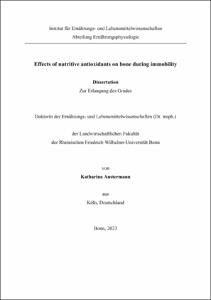Hensen, Jan-Peter: Grape phenolic maturity : Dynamics of polyphenol-polysaccharide interactions and the impact of grape seeds. - Bonn, 2024. - Dissertation, Rheinische Friedrich-Wilhelms-Universität Bonn.
Online-Ausgabe in bonndoc: https://nbn-resolving.org/urn:nbn:de:hbz:5-78673
Online-Ausgabe in bonndoc: https://nbn-resolving.org/urn:nbn:de:hbz:5-78673
@phdthesis{handle:20.500.11811/12272,
urn: https://nbn-resolving.org/urn:nbn:de:hbz:5-78673,
doi: https://doi.org/10.48565/bonndoc-390,
author = {{Jan-Peter Hensen}},
title = {Grape phenolic maturity : Dynamics of polyphenol-polysaccharide interactions and the impact of grape seeds},
school = {Rheinische Friedrich-Wilhelms-Universität Bonn},
year = 2024,
month = sep,
note = {Red wines contain various polyphenols that significantly impact their sensorial characteristics, making polyphenol extraction crucial for winemakers. Polyphenols are extracted from grape berries during maceration and fermentation, but this process is limited by polyphenol concentration and their interactions during and after extraction. These parameters change during berry ripening, prompting winemakers to optimize harvest schedules for their preferred polyphenol availability. Phenolic grape maturity measures the extractability and composition of polyphenols in grape berries, influenced by complex factors, with polyphenolmacromolecule interactions being the most significant. In this thesis multiple factors that change phenolic maturity in Cabernet Sauvignon and Pinot noir berries were analyzed. Grape seeds were analyzed as a significant contributor to the grape phenolic content to reveal their impact on phenolic grape maturity. Besides, the effect of grape cell wall polysaccharides on polyphenol extraction during fermentation was studied.
Grape seed analysis revealed minimal changes during late ripening stages, suggesting that, at least in cool climates, seeds are unreliable indicators of phenolic maturity, despite their widespread use. While polyphenol concentrations, especially galloylated flavan-3-ols in Pinot noir seeds, decreased, the overall seed proportion in berries decreased more significantly, potentially improving wine quality by reducing seed polyphenols.
Cell wall polysaccharides drastically affect the extraction and stability of polyphenols in red wines. The dynamic nature of interactions between polysaccharides and grape polyphenols is a direct result of the availability and competition between the interacting molecules. During grape ripening, the cell wall polysaccharide composition changes. This has a direct impact on the extraction and stability of polyphenols during winemaking, making polysaccharides an important factor in evaluating phenolic maturity. Generally, monomeric flavan-3-ols and tannin concentrations are more sensitive to interactions with grape cell wall polysaccharides than anthocyanins. However, pectin forms complexes with anthocyanins that have similar characteristics as polymeric pigments. Polymeric pigments are typically the reaction products of anthocyanins and flavan-3-ols, mostly proanthocyanidins. They are essential in red wines for preserving the red color for years, as anthocyanins by themselves are generally unstable in the conditions present in wines. During fermentation, the initial formation of pectin-anthocyanin complexes was severe, but most of the complexes were unstable, with only a fraction remaining after a year of wine aging.},
url = {https://hdl.handle.net/20.500.11811/12272}
}
urn: https://nbn-resolving.org/urn:nbn:de:hbz:5-78673,
doi: https://doi.org/10.48565/bonndoc-390,
author = {{Jan-Peter Hensen}},
title = {Grape phenolic maturity : Dynamics of polyphenol-polysaccharide interactions and the impact of grape seeds},
school = {Rheinische Friedrich-Wilhelms-Universität Bonn},
year = 2024,
month = sep,
note = {Red wines contain various polyphenols that significantly impact their sensorial characteristics, making polyphenol extraction crucial for winemakers. Polyphenols are extracted from grape berries during maceration and fermentation, but this process is limited by polyphenol concentration and their interactions during and after extraction. These parameters change during berry ripening, prompting winemakers to optimize harvest schedules for their preferred polyphenol availability. Phenolic grape maturity measures the extractability and composition of polyphenols in grape berries, influenced by complex factors, with polyphenolmacromolecule interactions being the most significant. In this thesis multiple factors that change phenolic maturity in Cabernet Sauvignon and Pinot noir berries were analyzed. Grape seeds were analyzed as a significant contributor to the grape phenolic content to reveal their impact on phenolic grape maturity. Besides, the effect of grape cell wall polysaccharides on polyphenol extraction during fermentation was studied.
Grape seed analysis revealed minimal changes during late ripening stages, suggesting that, at least in cool climates, seeds are unreliable indicators of phenolic maturity, despite their widespread use. While polyphenol concentrations, especially galloylated flavan-3-ols in Pinot noir seeds, decreased, the overall seed proportion in berries decreased more significantly, potentially improving wine quality by reducing seed polyphenols.
Cell wall polysaccharides drastically affect the extraction and stability of polyphenols in red wines. The dynamic nature of interactions between polysaccharides and grape polyphenols is a direct result of the availability and competition between the interacting molecules. During grape ripening, the cell wall polysaccharide composition changes. This has a direct impact on the extraction and stability of polyphenols during winemaking, making polysaccharides an important factor in evaluating phenolic maturity. Generally, monomeric flavan-3-ols and tannin concentrations are more sensitive to interactions with grape cell wall polysaccharides than anthocyanins. However, pectin forms complexes with anthocyanins that have similar characteristics as polymeric pigments. Polymeric pigments are typically the reaction products of anthocyanins and flavan-3-ols, mostly proanthocyanidins. They are essential in red wines for preserving the red color for years, as anthocyanins by themselves are generally unstable in the conditions present in wines. During fermentation, the initial formation of pectin-anthocyanin complexes was severe, but most of the complexes were unstable, with only a fraction remaining after a year of wine aging.},
url = {https://hdl.handle.net/20.500.11811/12272}
}









